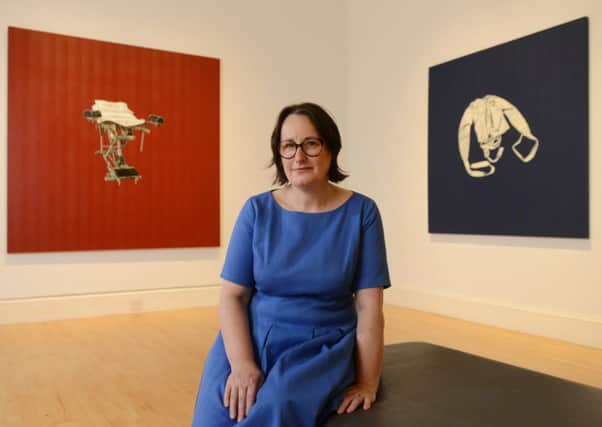Generation: 25 Years of Scottish Contemporary Art


Generation: 25 Years of Contemporary Art in Scotland - Scottish National Gallery of Modern Art, Scottish National Gallery
*****
Ross Sinclair is belting out Annie Laurie in the middle of a faux Highland glen, surrounded by stuffed fauna. For those who remember the original performance of Real Life Rocky Mountain at the CCA in 1996, it’s a chance to get nostalgic about a work of art which is at least partly about the perils of being nostalgic.
Advertisement
Hide AdIt is one of several key works which have been recreated for Generation, the countrywide celebration of contemporary art which rolls out across Scotland this summer. Just along the corridor is Graham Fagen’s Peek-A-Jobby, a life-like stage-set of a mucky student flat in which viewer can sit, watch TV and read a script of what has happened there. Downstairs is Douglas Gordon’s 24-hour Psycho, his frame-by-frame slowed down Hitchcock which won the Turner Prize in 1993, which many now pinpoint as the moment “all this” began.
It is “all this” – the remarkable explosion of contemporary art in Scotland since 1990 – which Generation addresses, in more than 50 exhibitions from the Borders to Stromness. However, the flagship show, curated by a team from National Galleries of Scotland and Glasgow Life with associate curator Katrina Brown, was unveiled this weekend in two major spaces at National Galleries of Scotland, flanked by major shows at GoMA and Tramway in Glasgow.
Many of the artists represented here crop up in other venues too. Ross Sinclair has a 20-year retrospective at the Collective Gallery, Graham Fagen has new work at Glasgow School of Art, Alison Watt, whose Shift paintings from 2000-2 are brought together in a beautiful, bright room at SNGMA, has a show at Perth Museum and Art Gallery. Jim Lambie, whom one might expect to find here, has a retrospective at the Fruitmarket instead.
It’s all very democratic and non-hierarchical. The SNGMA show contains new work by younger artists such as Alex Dordoy. More established artists present new work too: Claire Barclay has made a new body of sculpture, redolent with the feel of materials, the suggestiveness of objects and the practices of making. Victoria Morton presents a strong new figurative painting next to her seminal 1997 abstract Dirty Burning.
There is no single curatorial thread to follow. It encapsulates a period when art exploded in a multiplicity of directions. Each artist is given their own discrete space, which serves well the quieter work – Toby Paterson’s reflections on the modernist ideals behind Sighthill, Julie Robert’s restrained paintings of medical equipment. But the overall effect is that the works don’t talk much to one another.
The Scottish National Gallery show begins with a recreation of Steven Campbell’s On Form and Fiction from 1990, the only work in the show by an artist who is no longer living, and the only reference to the preceding generation of figurative painters.
Advertisement
Hide AdSeeing his work recreated is a joy, a teetering tour de force of painterly energy, the outpouring of a polymath intelligence, uneven sometimes, but, at its best, a kind of genius. Whether intentionally of not, this is a standard against which the other works in Generation will be measured. Again, each artist sits within a self-contained space. There are six Exposed Paintings by Calum Innes, made over a period of 20 years, testament to a consistent fascination with the processes of painting. David Shrigley looks unexpectedly strong in the room next door with a series of woodcut prints which bring gravitas to his felt-pen drawing style, and 12 pairs of enormous black ceramic boots.
In the long central room, Martin Boyce’s seminal installation for Tramway in 2002, Our Love Is Like The Flowers, The Rain, The Sea and The Hours is recreated, and while the space doesn’t conjure the illusion of outdoors quite as effectively as Tramway did, it demonstrates how thoroughly this piece has shaped the direction of Boyce’s work ever since. Only Karla Black’s tissue and cellophane sculpture in the entrance hall seems to struggle against the space. Hanging at eye level, too high to see over, not low enough to see into, it struggles a little with the viewer too.
Advertisement
Hide AdDo they measure up to Campbell? Yes, but they also emphasise their difference. The majority of these works are ideas-led, many of them fabricated to the artist’s instructions rather than made by their hands. It gives them a certain detachment. This, more than anything else, might be the shift between these generations. While they are accomplished, they are also devoid of Campbell’s edgy, uneven passion, and that is a little to be missed.
Scottish National Gallery of Modern Art until 25 January, 2015; Scottish National Gallery until 2 November.
For more information visit www.generationartscotland.org